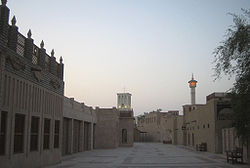
Al Bastakiya
Encyclopedia

Historic district
A historic district or heritage district is a section of a city which contains older buildings considered valuable for historical or architectural reasons. In some countries, historic districts receive legal protection from development....
in Dubai
Dubai
Dubai is a city and emirate in the United Arab Emirates . The emirate is located south of the Persian Gulf on the Arabian Peninsula and has the largest population with the second-largest land territory by area of all the emirates, after Abu Dhabi...
, United Arab Emirates
United Arab Emirates
The United Arab Emirates, abbreviated as the UAE, or shortened to "the Emirates", is a state situated in the southeast of the Arabian Peninsula in Western Asia on the Persian Gulf, bordering Oman, and Saudi Arabia, and sharing sea borders with Iraq, Kuwait, Bahrain, Qatar, and Iran.The UAE is a...
(UAE). Together with Al Shindagha
Al Shindagha
Al Shindagha , sometimes spelled Al Shindagah or Al Shindaga, is a neighbourhood in the traditional centre of the city of Dubai in the United Arab Emirates. From 1912 to 1958, the then ruler of Dubai, Sheikh Saeed Al Maktoum, lived in the area — his residence in Al Shindagha is now open to...
, Al Bastakiya is one of the oldest residential areas in the city of Dubai. Al Bastakiya is named after the Bastak
Bastak
Bastak is a city in and the capital of Bastak County, Hormozgan Province, Iran. At the 2006 census, its population was 8,376, in 1,765 families....
region of Iran
Iran
Iran , officially the Islamic Republic of Iran , is a country in Southern and Western Asia. The name "Iran" has been in use natively since the Sassanian era and came into use internationally in 1935, before which the country was known to the Western world as Persia...
, from where many of the residents emigrated. The emigrants are mostly Arabs that have migrated to Iran throughout history, then moved back to Arabia later. The locality lies along Dubai Creek
Dubai Creek
Dubai Creek or Khor Dubai is a saltwater creek located in Dubai, United Arab Emirates . It ends at Ras Al Khor Wildlife Sanctuary. Some sources say that the creek extended as far inland as Al Ain, and that the Ancient Greeks called it River Zara. Historically, the creek divided the city into two...
and includes narrow lanes and wind towers, as well as the Al Fahidi Fort, the oldest existing building in Dubai.
The construction of Al Bastakiya dates back to the 1890s. In its prime, the locality was capable of supporting 60 housing units, most of which were separated by narrow, winding lanes. Traditionally a stronghold of rich residents, the demographic of the locality changed with the discovery of oil, which resulted in many rich families relocating to other parts of the city. As a result, expatriate
Expatriate
An expatriate is a person temporarily or permanently residing in a country and culture other than that of the person's upbringing...
families moved into Al Bastakiya and the Al Souk Al Kabir
Al Souk Al Kabir
Al Souk Al Kabir , also referred to as Souk Al Kabir or Meena Bazaar, is a community in Dubai, United Arab Emirates . Al Souk Al Kabir is located in the area of Bur Dubai and is one of the oldest residential areas in the city and houses a predominantly Indian population, restaurants and shops...
area (referred to as Meena bazaar
Bazaar
A bazaar , Cypriot Greek: pantopoula) is a permanent merchandising area, marketplace, or street of shops where goods and services are exchanged or sold. The term is sometimes also used to refer to the "network of merchants, bankers and craftsmen" who work that area...
by immigrant residents).
In the 1970s about a half of Bastakiya was destroyed to make way for the development of a new office complex for the emirate's Ruler. The remaining area fell into some disrepair and, apart from the Majlis Gallery, an art and crafts centre, the wind tower houses became largely used as warehouses or for accommodation of expatriate labourers. A British architect, Rayner Otter, took up residence in one house and carried out extensive renovations within. In 1989 the Dubai Municipality scheduled the remaining area of Bastakiya to be demolished. Rayner Otter started a campaign to preserve the area and wrote to Britain's Prince Charles who was due to visit the emirate that year. When he arrived in Dubai, Prince Charles, who is known for his views on architecture and his love of historic buildings, asked to visit Bastakiya. Here he met Otter and explored the whole area. It is understood that during his visit Charles suggested to his hosts that Bastakiya should be preserved. Shortly after his departure the decision to demolish Bastakiya was reversed.
A project aimed at restoring the locality's old buildings and lanes was initiated by Dubai Municipality
Dubai Municipality
Dubai Municipality is the municipal body with jurisdiction over city services and the upkeep of facilities in the Emirate of Dubai, United Arab Emirates. It was established in 1954 by the then crown prince of Dubai, Rashid bin Saeed Al Maktoum...
in 2005.
What makes Al Bastakiya unique is its architecture. The wind tower, called barjeel , is in every house of Al Bastakiya. The number of barjeels a house has indicates the wealth of the owner family. Moreover, the doors of the houses are related to cultural behaviors. For example the main door of the house is large where as the inner door is short, and this is because when men entering the house they should bend down not facing women directly.
External links
- Passive Cooling in the UAE An article on design lessons learned from Bastakiya houses, via Carboun

